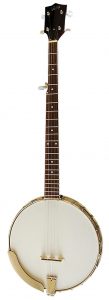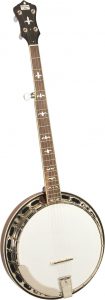Review: Banjos on Any Budget
Review: Banjos on Any Budget
Like any other stringed instrument, you’re not going to get a great sound out of your banjo unless you get it properly set up. Most banjos come off the shop wall with throwaway strings and a cheap bridge – the strings are typically light gauge and bridges tend to be lower and lighter than you might want. That said, it’s still possible to get a rough idea of the sound and quality of the instrument, and of the general build quality.
As with other stringed instruments it’s always possible to swap out things like machine heads and so forth, and it can be a good idea to upgrade this sort of thing if you like a particular instrument, but the factory hardware is of low quality. These four banjos were reviewed out of the box, and all of them would definitely benefit from a decent set up – which is not a gripe about the banjos themselves, but is definitely something you’ll want to bear in mind when out banjo shopping.
Gretsch G9410 Broadkaster, rrp $799
The Gretsch G9410 (that’s it pictured above) is a fine lower-cost resonator banjo. As soon as you pick it up you can feel that it doesn’t have the weight of more expensive models, which mostly comes down to using a lighter, rolled-brass tone ring and mahogany resonator. These lesser quality components translate into a bit of a trade-off – in order to produce a punchy, loud tone youd need to set the action higher than a lot of players might be comfortable with. If you set the action at a more playable level you will be likely to sacrifice tone and volume.
That’s certainly not to say this is a poor instrument, it’s more or less what you’d expect in the sub-$1000 price range. The tone is pleasant, but lacks the mid-range richness that you’d hope to find to find in a higher-end model. (Locally banjos currently retail for prices right up to $3500.) That said, the notes have a nice roll-off which is suitable for fast bluegrass playing.
The Broadkaster has good intonation and holds its tuning well, and its fretboard and inlays are clean and simple. If you weren’t planning on playing it acoustically very often, this could prove a good option for use in an amplified folk or country band, along with a decent pickup and pre-amp.
 Ibanez B200 Resonator, rrp $699
Ibanez B200 Resonator, rrp $699
The Ibanez B200 is surprisingly good for such a low price. It’s another resonator banjo with a rolled-brass tone ring and mahogany rim and resonator, and despite its relatively light weight and lower-cost components it has a surprisingly rich tone. It doesn’t have the clear midrange of the RK, but overall the tone is nice and even from bass to treble.It is richly decorated with mother-of-pearl inlays up and down the fretboard and headstock, which is kind of pretty, though, call me old-fashioned, personally I prefer just a few dots in the right places. The tuning hardware was a bit loose out of the box, but that was very easy to fix. Once done the instrument tuned up well and held its tuning. Intonation was fine, and though again you would have a trade-off between action and volume/tone with this model, it is very pleasant to play, with a warm tone at low volume. Enjoyable to play and well-priced, this would be a very good beginners instrument.
 Rover RB-30 Openback, rrp $550
Rover RB-30 Openback, rrp $550
The Rover RB-30 is a sweet little number. You’ll notice it looks quite different to the other three banjos on review here – closer to an old-time banjo, without a resonator or tone ring. It’s also got an all-metal body, which is reasonably unusual these days, but was apparently a common way to build a banjo around 70 or so years ago.The open-back design is commonly used in old-time banjo playing, the style that developed in the Appalachians in the early 20th Century. This style has its followers in NZ, but you have to seek them out – folk clubs and folk festivals are a good place to start, and David Ward, for example, has been using one in his theatre work recently. Broadly speaking, the old-time banjo sound tends to be a bit more mellow than the bluegrass sound, although there are exceptions to this of course.
Because of its metal pot, the RB-30 has a brighter, more twangy sound than we usually associate with the old-time style, and to my ear its louder than a lot of old-time banjos out there. Because it doesn’t have a tone ring or a resonator, and because the pot is made out of aluminium rather than wood it’s surprisingly lightweight, which could make it a good choice for a travelling instrument. With its bright, twangy sound it could hold its own in a bluegrass setting, while the open back won’t raise any eyebrows in an old-time session either. I’d want to replace the machine heads, which feel a bit flimsy, but other than that it seems like a solid low-cost instrument that you wouldn’t mind chucking about a bit.
The other three banjos will be more familiar-looking to Kiwi eyes. These are all resonator banjos, of the type that are used traditionally in bluegrass music. More recently, they’re commonly used in a lot of other folk, country and alt-folk styles, and you’ll see resonator banjos slung around the place by players like Jess Shanks of The Eastern, and Dave Khan, of just about every alt-folk band in Auckland. Resonator banjos are generally louder and have a punchier tone than the open-backed design, and the sound fits in well in amplified country and folk styles.
 Recording King Resonator 35BR, rrp $1495
Recording King Resonator 35BR, rrp $1495
With all of these banjos retailing under $1500 it’s unlikely that any of them are going to knock your ears off tone-wise, but the Recording King 35BR really does stand out as a quality instrument, albeit at a higher price than the others.When it comes to resonator banjos, a good general rule is the heavier the better – the quality of the rim, the resonator and the tone ring (that’s the metal part between the rim and the resonator, with the holes in it) are roughly correlated with weight, since the better quality materials are more dense and (generally) have a better resonance.
This instrument has a bell brass cast tone ring and maple resonator and rim. It feels heavy and solid as soon as you pick it up – and the tone is really something else. It’s got nice rich mids to balance a sparkly treble, and with some heavier strings it sounds like it could really ring in the bass.
The sound and feel of this instrument put it in a class above the others, and it’s well suited to the bluegrass style with a clear tone, clean decay and good action and intonation right out of the box. The standard tuning and tensioning hardware is all of high quality, the nut is bone rather than plastic, so this is a banjo you could really just play as it comes. The fretboard inlays and frets are all well put together and smoothly finished, so it’s comfortable and accurate to play. It also has a really classic look, with Recording King’s seagull inlays and fleur-de-lis on the headstock.
Auckland-based Sam Prebble is a fixture of NZ’s alt-folk scene. As frontman for Bond Street Bridge, his award-winning show The Explorers Club: Antarctica has been touring arts festivals countrywide over the past 18 months. www.bondstreetbridge.com
